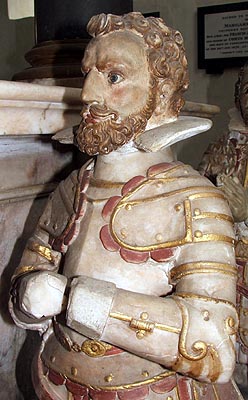 |
 |
|||
|
|
Francis was the sixth son of the Treasurer of England, Sir Francis Knollys Senior of Greys' Court in Oxfordshire, and his wife, Catherine Carey, a maternal cousin of Queen Elizabeth I. From the age of about twenty-two, Francis was elected MP for Oxford, where his father was high steward, and he served the city in Parliament for the next twenty years. He was well known at Court as "young Sir Francis", although his rise their was largely due to the influence of his brother-in-law, the Earl of Leicester, rather than her father. Francis spent his youth seeking his fortune by piracy. He was apparently part of Sir Humphrey Gilbert's abortive attempt at the further colonisation of North America in 1578. He accompanied his brother, Henry, who fell out with the expedition's leader and, instead, took three of his ships to despoil the Spanish coast. Eight years later, he served as a Rear-Admiral under Sir Francis Drake on a more official privateering campaign of nineteen ships and other smaller vessels, some provided by Queen Elizabeth herself. They set sail across the Atlantic on 14th September, with Francis commanding the 'Leicester'. In the Caribbean, they attacked everything Spanish that they came across. They plundered both Santiago and Porta Praya in the Cape Verde Islands and reduced them to ashes. They then burnt San Domingo and captured Cartegena on the Spanish Main, which was held to ransom. Then, for a month, the company sailed near the Capo St. Antonio, considering the possibility of attacked Havana, but its fortifications were too strong. So they sailed up the Florida Coast and, instead, sacked the large settlement of St. Augustine before burning it to the ground. In Albemarle Sound, Drake, Knollys and their party rescued Raleigh's desperate settlers from Roanoke Island and then headed for home. They arrived in Portsmouth in July 1586. There had been considerable friction between Drake and Knollys, but the expedition was a great success and Francis, no doubt, took his share of the £65,000 worth of booty they brought with them. Soon afterwards, Francis was serving with his brother-in-law, the Earl of Leicester, in the Netherlands, following the Dutch and English defeat at the Battle of Zutphen. Leicester knighted him at Flushing in December 1587. During the Armada Invasion of 1588, he was back home acting as commissioner for musters and colonel of the militia for Hertfordshire, where Leicester was the Lord Lieutenant. The following year, he was sent in pursuit of his nephew, the Earl of Essex, in order to stop him defying the Queen and joining the Portugal expedition. However, he was not successful. By 1595, Sir Francis Junior's father had leased, from the Crown, the manor of Battle on the western side of Reading in Berkshire, and it seems likely that the son moved in soon afterwards with his young family. He had married Lettice, the daughter of John Barrett of Hanham in Gloucestershire, by license dated 21st December 1588. They were to inherit the property within a year, but also resided at 'Abbey House', the old town-house of Sir Francis Junior's father in Reading town's centre. In 1596, Sir Francis was appointed Deputy Lord Lieutenant of Berkshire and, the following year, was elected an MP for the county, being returned again in 1604 and 1625. Like his father, he was a devoted protestant and, in 1599, was commissioned to search out Catholic priests which were thought to be hiding at Ufton Court. Although he, apparently, had no involvement in the Essex Rebellion, instigated by his nephew, Sir Francis was unfortunate enough to be at Essex House when the Queen's men arrived to arrest the Earl. He was taken into custody himself and placed in the charge of his kinsman, Sir Francis Leighton, and then his brother, Sir Robert, but was soon released. Sir Francis' remarkable parliamentary career culminated in his final election as MP for Reading in the Long Parliament of 1640 which saw the start of the Civil War. He was aged about ninety and was described by his contemporaries as "the ancientest Parliament man in England". His son, Francis, who predeceased him in 1643, was also MP for Reading in 1625, 1626 and 1628; whilst his daughter, Lettice, became, firstly, the wife of Sir Thomas Vachell of Coley Park, and then the second wife of the famous Parliamentarian, John Hampden. Not long before his death in the Spring of 1648, Sir Francis built the Knollys Aisle on the south side of St. Laurence's Church in Reading. It was a private transept within which his family sat for generations of Sunday services. He and many of his descendants were buried beneath it, but the structure was demolished in 1868.
|
|||
| © Nash Ford Publishing 2001; 2008. All Rights Reserved. | ||||



 Sir
Francis Knollys Junior (d.1648)
Sir
Francis Knollys Junior (d.1648)